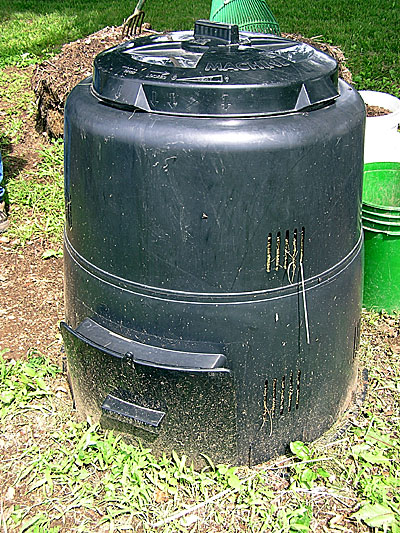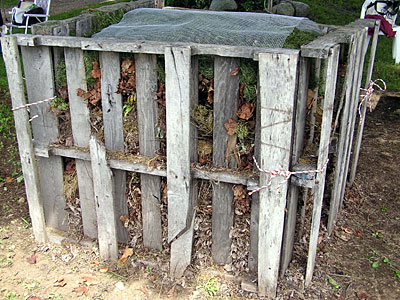 |
| Master Gardeners provided this display of compost containers and a thermometer at Brae Maple Farm one summer. They include a rotating drum (Compos-Tumbler), a bin made from recycled plastic and one made from pallets. A series of three wooden bins in a row (made from pallets or constructed of wood) will enable a gardener to turn piles more easily. |
 |
 |
 |
By Eric Sideman, Ph.D.
Composting is a natural, biological process in which microorganisms use organic materials as food and leave a residue of digested organic matter that is nearly completely decomposed. Composting is the same as the decomposition that happens to all living things when they die, except that you control composting in order to provide optimum conditions for the microbes, and the process takes place in a specific location so that you can collect the product.
Benefits of Composting
Composting is a fundamental part of most organic systems, because it recycles and conserves nutrients and provides a product that improves the soil. Compost is one of the best soil conditioners. The organic matter in compost is like soil humus and is very stable. It builds soil structure, adds water and nutrient holding capacity to the soil and aerates the soil.
Compost also provides fertility. Well-made compost will not “burn” crops, because its nutrients are usually well balanced, and it’s low in salt. The carbon to nitrogen (C:N) ratio of well-made compost is about 15:1, and this material will neither lock up nitrogen1 nor shock soil life or plants with too much free nitrogen. This is particularly true with composted manure: Before composting, some manure (such as horse manure mixed with sawdust bedding) has a great deal of carbonaceous bedding; other manures, such as chicken manure, are loaded with very soluble nitrogen salts that will burn crops.
Properly composted manure has more benefits over fresh manure: It has no bad odor; is less likely to pollute the environment; and has killed human pathogens. A key benefit of proper composting is that the material gets hot, so whether the compost comes from manure and/or plant material, the heat of composting kills weed seeds and plant pathogens.
Drawbacks of Composting
A significant amount of nutrients can be lost during composting. Soluble nutrients (including soluble forms of nitrogen) can be lost through leaching. Nitrogen usually is lost as ammonia or other gaseous nitrogen compounds as well. A good system for handling uncomposted manure and applying it to the soil can conserve more nitrogen than composting can. On the other hand, composting can conserve more nitrogen than a poor system of handling manure or applying it to soil in hot, dry weather or other poor weather conditions.
Another drawback of composting is that compost releases nutrients slowly. In many ways this is a benefit, but sometimes growers need the quicker release that fresh manure provides. Knowing when to use composted or fresh manure is an important decision for farm-scale growers, but gardeners are usually served better by compost. Gardeners can use soybean, alfalfa or feather meal for a quickly available, more concentrated source of nitrogen.
Making Compost
The key to making compost is to cater to the microbes so that their populations increase quickly and work fast. The most important microbes are bacteria, and the kind of bacteria that work best for composting need air, water and food. Successful composting practices keep these bacteria well supplied with air, water and food all the time. A working compost pile will have lots of air spaces, will be moist but not wet (because if it gets too wet, the pore spaces fill with water instead of air), and the pile will be mixed at the right times (because bacteria cannot walk over to get food when they use up what is near them, so you have to bring food to them). The following tips tell how to keep the bacteria working fast.
Where?
Composting is done in piles or in bins. Gardeners usually use bins because they make composting look neat. Bins also help hold the shape of a small compost pile, and that is important. A compost pile must be the proper height and width to insulate itself enough to get hot. A pile should be at least 4 feet high and 4 feet wide, and however long you want. The biochemical activity of the microorganisms giving off heat makes the pile hot, and if the pile is large enough, this heat does not escape quickly. If the pile is too small, it will not get hot. Decomposition still takes place, and the resultant material is still a good soil amendment, but slow decomposition in small piles does not kill weed seeds or plant or human pathogens, and nutrients in the slowly composting material have a greater risk of being lost.
Compost bins come in many designs. My favorite consists of three side-by-side bins. In this system the first bin is used to store material until you have enough to build a big enough pile. Then you can build your pile in the second bin and flip it back and forth from the second to the third bin when you need to mix and aerate it.
What?
Anything that was once alive will compost when it is dead, but materials that decompose quickly are recommended for a compost pile. Some materials are too wet, some are too dry; others have too much or too little nitrogen.2 Build a pile that is moist, has lots of air spaces and has an initial C:N ratio of about 20-40:1. To achieve this, mix ingredients: wet with dry, compacted with airy, low C:N with high C:N.
Here are some examples of common compost feedstock:
| Material | C:N | Wet or Dry | Airy or Heavy |
| Grass clippings, fresh | 10 | wet | airy |
| Leaves, dry | 50 | dry | airy |
| Kitchen scraps | 15 | wet | heavy |
| Dairy manure | 15 | wet | heavy |
| Laying hen manure | 5 | wet | heavy |
| Sheep manure | 15 | medium | heavy |
| Horse manure, w/bedding | 35 | medium | heavy |
| Seaweed | 17 | medium | heavy |
| Sawdust | 300 | dry | airy |
A few organic materials should be avoided in backyard compost. Meat often attracts critters. Bones and fat decompose very slowly. Lawn clippings from lawns that are heavily treated with herbicides have left a residue of herbicides in the finished compost, and this residue can harm or even kill vegetable plants.
Materials that are large, such as corn stalks, can be chopped or shredded to fit into the compost bin and to make composting go faster (because more surface area is exposed to bacteria).
How to Build the Pile
Commercial composters get their feedstock tested, then develop formulas that get the C:N ratio and the moisture and air just right. In the back yard, estimate by making layers of wet and dry and nitrogen-rich and carbon-rich materials. For example, a pile made initially of 6-inch layers of leaves with 2-inch layers of dairy manure should compost fine. Add layers until the pile is about 4 x 4 feet.
Managing the Pile
The pile has to be mixed occasionally so that the bacteria do not use up the food or air near them. The best way for backyard composters to decide when to turn and mix the pile is by monitoring the temperature. The pile must reach at least 130 F. in order to kill most weed seeds and pathogens. Do not let the pile go above 160˚, because that much heat will kill the bacteria working the compost. Turn a pile when it reaches 140˚-150˚. After each turning, the pile cools and then reheats. Usually after three or so turnings, it does not heat that high again; let the pile sit and cure then. Curing is the period of time when normal soil critters, rather than heat-loving bacteria, move into the compost.
Gardeners turn compost piles with hay forks or similar tools. Some spread the material on the ground so that it is about a foot thick, go over it with a rototiller, then make the pile again. Farmers put material through a manure spreader or turn with a compost turner. The important point is to get all of the material to the part of a pile that heats up (usually near the center of the pile) at least once during the composting.
What if the Pile Does Not Heat?
Backyard piles will not heat sufficiently if they are too small, do not have enough nitrogenous material, are too dry or too wet.
Want to Know More?
A great, detailed, bulletin about composting is available from Cooperative Extension. It’s called On-Farm Composting Handbook (NRAES 54). The cost is $25. To order, see https://extensionpubs.umext.maine.edu.
About the author: Eric Sideman is MOFGA’s “extension agent.” You can ask him questions about your gardens or crops. Call 946-4402 or email [email protected].
1 If the C:N ratio is very high, e.g., over 50:1, then microorganisms feeding on the carbonaceous material will compete with crops for nitrogen in the soil. The crops are likely to suffer from an induced nitrogen deficiency until the microorganisms finish decomposing the material and they themselves die and release nitrogen back to the soil. This is called nitrogen lock up.
2 The idea of too little or too much nitrogen is based on the C:N ratio discussed in footnote 1. Bacteria use carbonaceous material in the pile as a good source of energy for their life functions. They use nitrogenous material in the pile to build proteins; they need a lot of protein to increase in numbers. A pile with a C:N ratio that is too low (less than 20:1) will not have enough energy to support the bacteria and will waste nitrogen and often smell bad. A pile with a C:N ratio that is too high (more than 40:1) will not have enough nitrogen for the bacterial population to grow large, so the pile will decompose very slowly.

